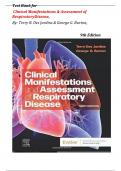Test Bank for
Clinical Manifestations & Assessment of
RespiratoryDisease,
By: Terry R. Des Jardins & George G. Burton,
9th Edition
, TABLE OF CONTENT
PART I: ASSESSMENT OF CARDIOPULMONARY DISEASE
SECTION I: Bedside Diagnosis
Chapter 1.The Patient Interview
Chapter 2.The Physical Examination
Chapter 3.The Pathophysiologic Basis for Common Clinical Manifestations
SECTION II: Clinical Data Obtained from Laboratory Tests and Special Procedures — Objective
Findings
Chapter 4.Pulmonary Function Testing
Chapter 5.Blood Gas Assessment
Chapter 6.Assessment of Oxygenation
Chapter 7.Assessment of the Cardiovascular System
Chapter 8.Radiologic Examination of the Chest
Chapter 9.Other Important Tests and Procedures
SECTION III: The Therapist-Driven Protocol Program — The Essentials
Chapter 10.The Therapist-Driven Protocol Program
Chapter 11.Respiratory Failure and Ventilatory Management Protocols
Chapter 12.Recording Skills and Intra-Professional Communication
PART II: OBSTRUCTIVE LUNG DISEASE
Chapter 13.Chronic Obstructive Pulmonary Disease, Chronic Bronchitis, and Emphysema
Chapter 14.Asthma
Chapter 15.Cystic Fibrosis
Chapter 16.Bronchiectasis
PART III: LOSS OF ALVEOLAR VOLUME
Chapter 17.Atelectasis
PART IV: INFECTIOUS PULMONARY DISEASE
Chapter 18.Pneumonia, Lung Abscess Formation, and Important Fungal Diseases
Chapter 19.Tuberculosis
PART V: PULMONARY VASCULAR DISEASE
Chapter 20.Pulmonary Edema
Chapter 21.Pulmonary Vascular Disease: Pulmonary Embolism and Pulmonary Hypertension
PART VI: CHEST AND PLEURAL TRAUMA
Chapter 22.Flail Chest
Chapter 23.Pneumothorax
PART VII: DISORDERS OF THE PLEURA AND THE CHEST WALL
Chapter 24.Pleural Effusion and Empyema
Chapter 25.Kyphoscoliosis
PART VIII: LUNG CANCER
Chapter 26.Cancer of the Lung
PART IX: ENVIRONMENTAL LUNG DISEASES
Chapter 27.Interstitial Lung Diseases
PART X: DIFFUSE ALVEOLAR DISEASE
Chapter 28.Acute Respiratory Distress Syndrome
PART XI: NEURO-RESPIRATORY DISORDERS
Chapter 29.Guillain-Barre Syndrome
Chapter 30.Myasthenia Gravis
Chapter 31.Cardiopulmonary Assessment and Care of Patients with Neuromuscular Disease
PART XII: SLEEP-RELATED BREATHING DISORDERS
Chapter 32.Sleep Apnea
PART XIII: NEWBORN AND EARLY CHILDHOOD CARDIOPULMONARY DISORDERS
Chapter 33.Newborn Assessment and Management
Chapter 34.Pediatric Assessment and Management
Chapter 35.Meconium Aspiration Syndrome
Chapter 36.Transient Tachypnea of the Newborn
,Chapter 37.Respiratory Distress Syndrome
Chapter 38.Pulmonary Air Leak Syndromes
Chapter 39.Respiratory Syncytial Virus Infection (Bronchiolitis)
Chapter 40.Bronchopulmonary Dysplasia
Chapter 41.Congenital Diaphragmatic Hernia
Chapter 42.Congenital Heart Diseases
Chapter 43.Croup and Croup-like Syndromes: Laryngotracheobronchitis, Bacterial Tracheitis, and Acute
Epiglottitis
PART XIV: OTHER IMPORTANT TOPICS
Chapter 44.Near Drowning/Wet Drowning
Chapter 45.Smoke Inhalation, Thermal Lung Injuries, and Carbon Monoxide Intoxication
, Chapter 01: The Patient Interview
Des Jardins: Clinical Manifestations and Assessment of Respiratory Disease, 9th
Edition
MULTIPLE CHOICE
1. The respiratory care practitioner is conducting a patient interview. The main purpose of this
interview is to:
a. review data with thePatient.
b. gather subjective data from thePatient.
c. gather objective data from thePatient.
d. fill out the history form or checklist.
SOLUTION:B
The interview is a meeting between the respiratory care practitioner and thePatient. It allows the
collection of subjective data about the patient’s feelings regarding his/her
condition. The history should be done before the interview. Although data can be reviewed,
that is not the primary purpose of the interview.
2. For there to be a successful interview, the respiratory therapist must:
a. provide leading questions to guide the Patient.
b. reassure thePatient.
c. be an active listener.
d. use medical terminology to show knowledge of the subject matter.
SOLUTION:C
The personal qualities that a respiratory therapist must have to conduct a successful interview include
being an active listener, having a genuine concern for the patient, and having empathy. Leading
questions must be avoided. Reassurance may provide a false sense of comfort to thePatient. Medical
jargon can sound exclusionary and paternalistic to aPatient.
3. Which of the following would be found on a history form?
1. Age
2. Chief complaint
3. Present Health
4. Family history
5. Health insurance provider
a. 1, 4
b. 2, 3
c. 3, 4, 5
d. 1, 2, 3, 4
SOLUTION:D
Age, chief complaint, present Health, and family history are typically found on a Health history
form because each can impact the patient’s Health. Health insurance provider information,
whileneeded for billing purposes, would not be found on the history form.




